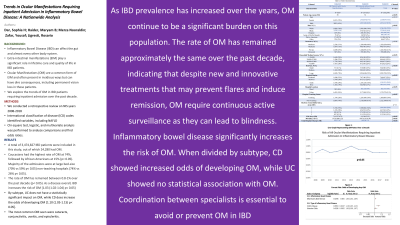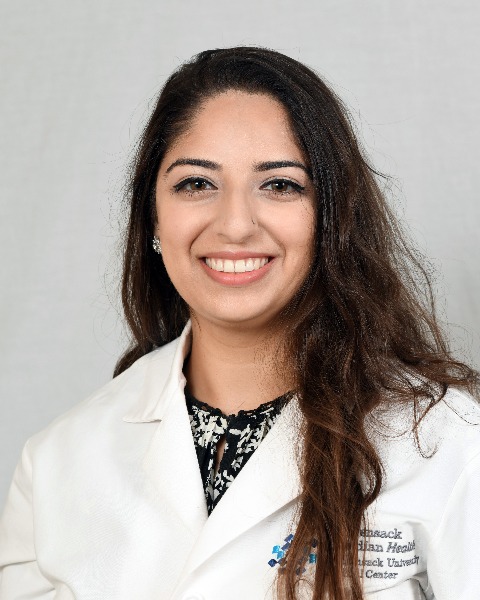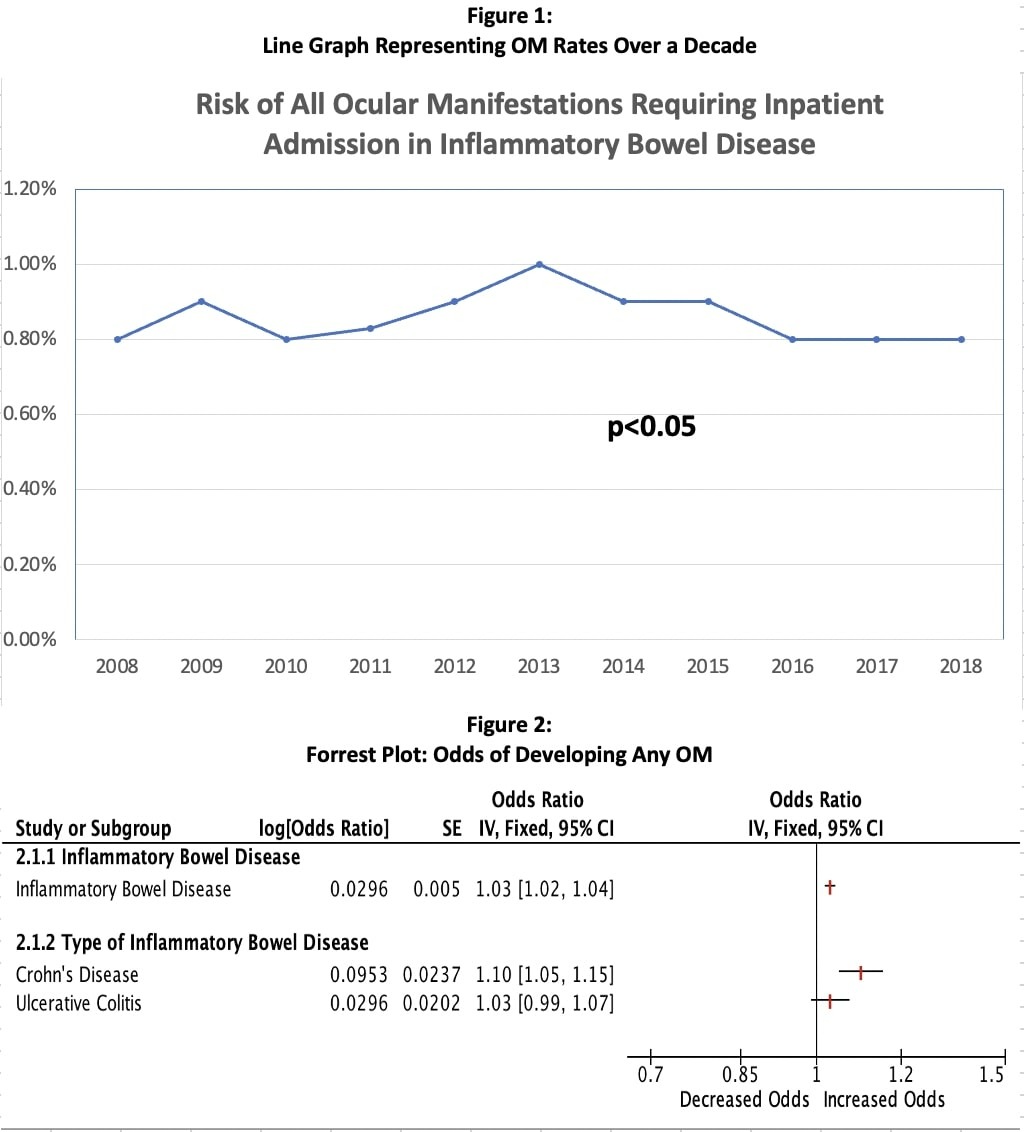Back


Poster Session D - Tuesday Morning
Category: Colon
D0101 - Trends in Ocular Manifestations Requiring Inpatient Admission in Inflammatory Bowel Disease: A Nationwide Analysis Over a Decade
Tuesday, October 25, 2022
10:00 AM – 12:00 PM ET
Location: Crown Ballroom

Has Audio

Sophia H. Dar, MD
Hackensack University Medical Center
South Amboy, NJ
Presenting Author(s)
Sophia H. Dar, MD1, Maryam Haider, MD2, Nooraldin Merza, MD3, Yousaf Zafar, 4, Rosario H. Ligresti, MD5
1Hackensack University Medical Center, South Amboy, NJ; 2Wayne State University/Detroit Medical Center Sinai Grace Hospital, Detroit, MI; 3Wayne State University Medical Center, Detroit, MI; 4University of Mississippi Medical Center, Madison, MS; 5Hackensack University Medical Center, Hackensack, NJ
Introduction: Inflammatory Bowel Disease (IBD) can affect the gut and almost every other body system. Extra-intestinal manifestations (EIM) play a significant role in lifetime care and quality of life in IBD patients. Ocular Manifestations (OM) are a common form of EIM and often present in insidious ways but can have dire consequences, including permanent vision loss in these patients. We explore the trends of OM in IBD patients requiring inpatient admission over the past decade.
Methods: This study is a retrospective review of the healthcare cost and utilization project: national inpatient sample for 2008-2018 was conducted. Patient and institutional characteristics were extracted for the analysis. International classification of disease (ICD) codes are used to identify variables including optic neuritis, conjunctivitis, uveitis, IBD, and other comorbidities. Chi-square test and propensity matched-multivariate logistic regression were used to analyze the risk of OM, mortality, and effects on total hospital charges and length of stay.
Results: A total of 3,474,827 IBD patients were included in this study, out of which 24,280 had OM. Caucasians had the highest rate of OM at 74%, followed by African Americans at 15% (p< 0.05). Majority of the admissions were at large bed-size (70% vs 59% p< 0.05) non-teaching hospitals (74% vs 26% p< 0.05). The rate of OM has remained between 0.8-1% over the past decade (p< 0.05). As a disease overall, IBD increases the risk of OM [1.03 (1.02-1.04) p< 0.05). By subtype, UC does not have a statistically significant impact on OM, while CD does increase the odds of developing OM [1.10 (1.05-1.15) p< 0.05]. The most common OM seen were cataracts, conjunctivitis, uveitis, and episcleritis.
Discussion: As IBD prevalence has increased over the years, OM continue to be a significant burden on this population. The rate of OM has remained approximately the same over the past decade, indicating that despite new and innovative treatments that may prevent flares and induce remission, OM require continuous active surveillance as they can lead to blindness. As a whole, inflammatory bowel disease significantly increases the risk of OM. When divided by subtype, CD showed increased odds of developing OM, while UC showed no statistical association with OM. Coordination between specialists is essential to avoid or prevent OM in IBD.

Disclosures:
Sophia H. Dar, MD1, Maryam Haider, MD2, Nooraldin Merza, MD3, Yousaf Zafar, 4, Rosario H. Ligresti, MD5. D0101 - Trends in Ocular Manifestations Requiring Inpatient Admission in Inflammatory Bowel Disease: A Nationwide Analysis Over a Decade, ACG 2022 Annual Scientific Meeting Abstracts. Charlotte, NC: American College of Gastroenterology.
1Hackensack University Medical Center, South Amboy, NJ; 2Wayne State University/Detroit Medical Center Sinai Grace Hospital, Detroit, MI; 3Wayne State University Medical Center, Detroit, MI; 4University of Mississippi Medical Center, Madison, MS; 5Hackensack University Medical Center, Hackensack, NJ
Introduction: Inflammatory Bowel Disease (IBD) can affect the gut and almost every other body system. Extra-intestinal manifestations (EIM) play a significant role in lifetime care and quality of life in IBD patients. Ocular Manifestations (OM) are a common form of EIM and often present in insidious ways but can have dire consequences, including permanent vision loss in these patients. We explore the trends of OM in IBD patients requiring inpatient admission over the past decade.
Methods: This study is a retrospective review of the healthcare cost and utilization project: national inpatient sample for 2008-2018 was conducted. Patient and institutional characteristics were extracted for the analysis. International classification of disease (ICD) codes are used to identify variables including optic neuritis, conjunctivitis, uveitis, IBD, and other comorbidities. Chi-square test and propensity matched-multivariate logistic regression were used to analyze the risk of OM, mortality, and effects on total hospital charges and length of stay.
Results: A total of 3,474,827 IBD patients were included in this study, out of which 24,280 had OM. Caucasians had the highest rate of OM at 74%, followed by African Americans at 15% (p< 0.05). Majority of the admissions were at large bed-size (70% vs 59% p< 0.05) non-teaching hospitals (74% vs 26% p< 0.05). The rate of OM has remained between 0.8-1% over the past decade (p< 0.05). As a disease overall, IBD increases the risk of OM [1.03 (1.02-1.04) p< 0.05). By subtype, UC does not have a statistically significant impact on OM, while CD does increase the odds of developing OM [1.10 (1.05-1.15) p< 0.05]. The most common OM seen were cataracts, conjunctivitis, uveitis, and episcleritis.
Discussion: As IBD prevalence has increased over the years, OM continue to be a significant burden on this population. The rate of OM has remained approximately the same over the past decade, indicating that despite new and innovative treatments that may prevent flares and induce remission, OM require continuous active surveillance as they can lead to blindness. As a whole, inflammatory bowel disease significantly increases the risk of OM. When divided by subtype, CD showed increased odds of developing OM, while UC showed no statistical association with OM. Coordination between specialists is essential to avoid or prevent OM in IBD.

Figure: Figure 1: Line graph of the OM over a decade
Figure 2: Odds of developing any OM
Figure 2: Odds of developing any OM
Disclosures:
Sophia Dar indicated no relevant financial relationships.
Maryam Haider indicated no relevant financial relationships.
Nooraldin Merza indicated no relevant financial relationships.
Yousaf Zafar indicated no relevant financial relationships.
Rosario Ligresti — NO DISCLOSURE DATA.
Rosario Ligresti indicated no relevant financial relationships.
Sophia H. Dar, MD1, Maryam Haider, MD2, Nooraldin Merza, MD3, Yousaf Zafar, 4, Rosario H. Ligresti, MD5. D0101 - Trends in Ocular Manifestations Requiring Inpatient Admission in Inflammatory Bowel Disease: A Nationwide Analysis Over a Decade, ACG 2022 Annual Scientific Meeting Abstracts. Charlotte, NC: American College of Gastroenterology.

